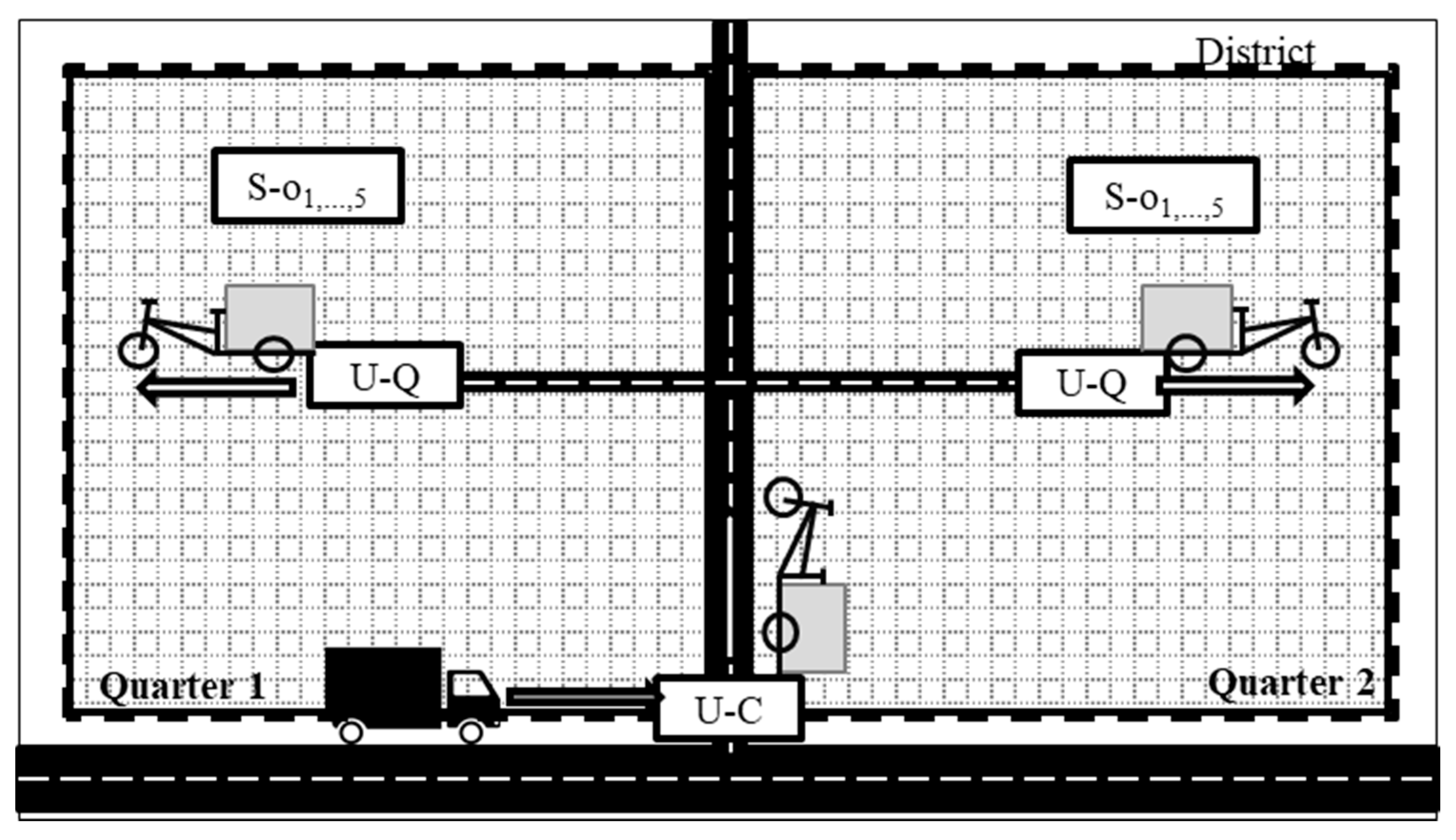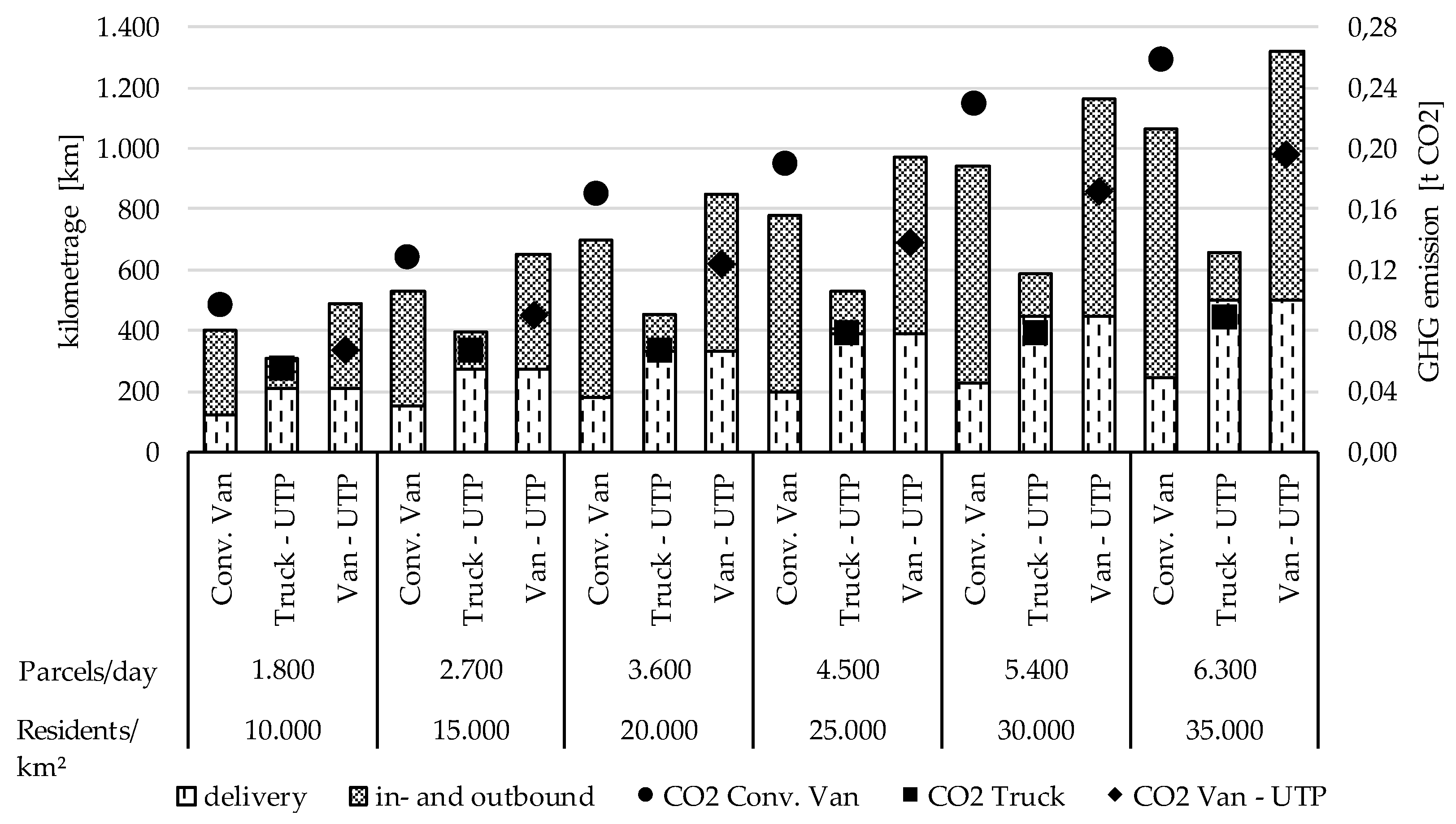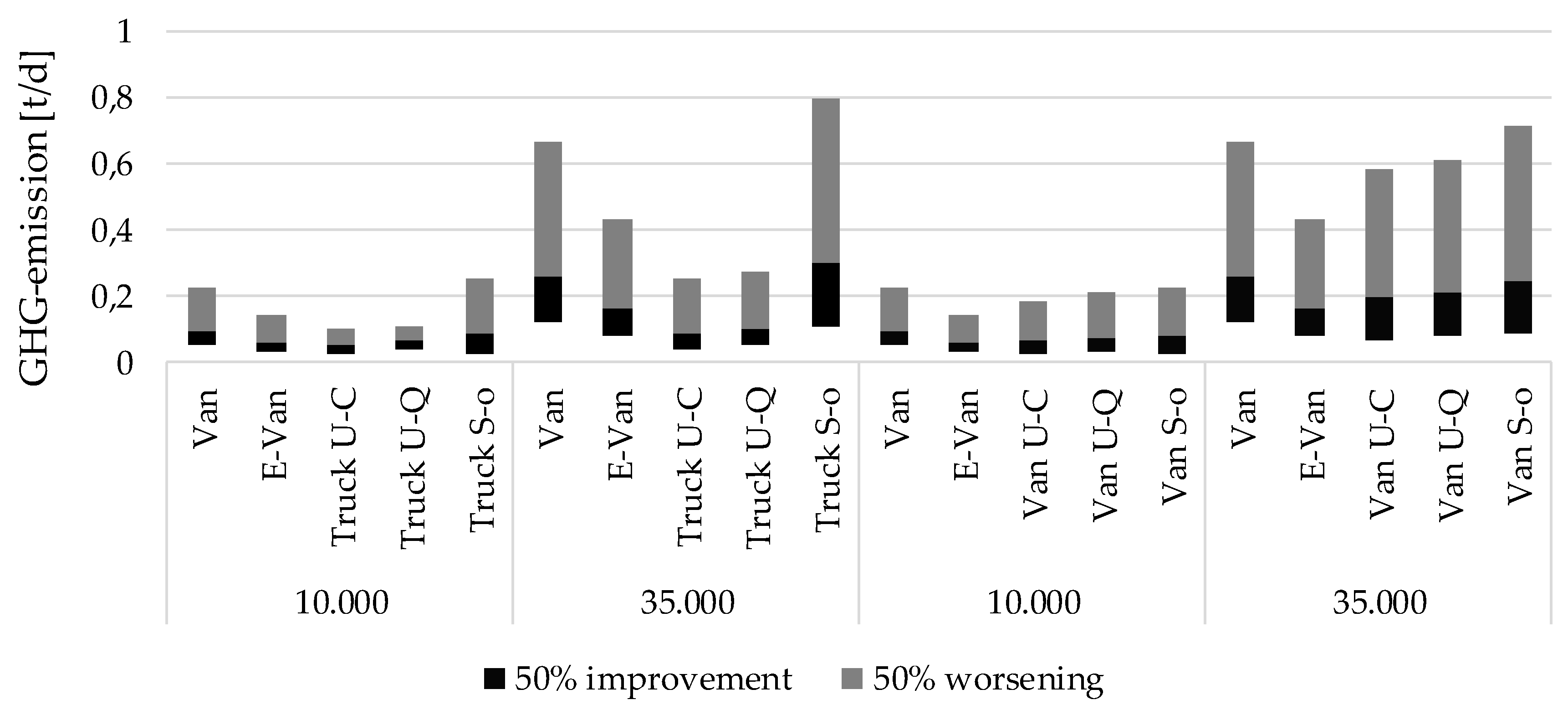As the greening of urban logistics is increasingly becoming a priority for cities all over the world in these days of global warming and urbanization, logistics providers and municipalities must quickly produce new concepts for the last mile, which has long been overlooked [
1,
2]. Urban and private planners are emphasizing the incorporation of cargo bikes in sustainable urban mobility plans [
3,
4]. Courier, express, and parcel (CEP) services are increasingly collaborating with municipalities to implement small urban transshipment points (UTPs), sometimes called satellites [
5]. Well-functioning examples [
6,
7] demonstrate their cost effectiveness and potential to cut greenhouse gas (GHG) emissions.
Promoting the use of cargo bikes systems as the dominant logistics network for distinct urban districts requires the provision of land for UTPs. Interviewed industry experts indicate that the establishment of such facilities is primarily contingent on identifying suitable sites since land is limited and subject to competition for different potential uses [
8]. While municipalities must provide land for essential infrastructure, they have virtually no guidelines for identifying suitable candidate sites for UTPs. Different population densities and business populations dictate the freight requirements in a district [
9] and thus affect logistics networks significantly. The problematic situation of siting UTPs is exacerbated by the lack of a one-size-fits-all solution for districts with different population densities and business populations. This means, for instance, that public or industry planners have no information on whether siting a UTP in a district’s center or on its periphery, or siting one large UTP or multiple smaller ones is better in terms of traffic and emissions.
1.1. Literature Survey and Research Gap
Urban logistics research and solutions for its sustainability is a trendy research topic [
10]. Although public authorities form a dominant perspective in urban logistics research [
11], most work is focusing innovations, best-practices, and technical solutions on a small scale, often neglecting environmental and social aspects [
10].
Cargo bikes are emission-free, environmentally friendly vehicles [
3]. Furthermore, they constitute a viable means of transport in urban delivery systems [
12] and can cut costs of delivery [
6,
13]. Their logistical benefit arises from the potential to reduce driving time over short distances in dense urban settings, especially with higher levels of congestion [
14]. Thus, many field trials and operational cargo bike delivery networks are deployed by CEP providers. Although UTPs are an essential component, their strategic siting is mostly neglected and candidate sites are not available [
15]. One strain of research at this point are planning handbooks. Stiehm et al. [
16] provide profound insights into layouts and corresponding dimensions of internal areas for logistics operations, legislative aspects, and emphasize an active role of urban planning. The handbook of Assmann et al. [
15] also deals with UTP siting, but concentrates on the planning process, acceptability, and cycling infrastructure. They favor cooperative UTPs (cUTPs), which are jointly used by several CEP-companies. Both publications clearly outline the need for a strategic planning of UTPs and the provision of corresponding space by cities.
Cargo bikes are generally seen as a means to cut emissions. Concerning GHG emissions, this is even the case when the deployment of cargo bikes worsens speed and increases delay times as Melo and Baptista [
17] demonstrate. A microscopic traffic simulation indicates that improvements can be achieved until the threshold of cargo bikes substitutes approximately 10% of delivery vans. However, the spatial frame covers just one street rather than a whole district. Assmann et al. [
15] demonstrate by means of microscopic traffic simulation that more than 20 cargo bikes an hour in small streets used by bikes and vehicles in equal rights decrease quality of traffic flow. This changes when the effect of parked cargo bikes for delivery on traffic flow is compared to parked vans on the road. Cargo bikes, thanks to smaller dimensions benefit traffic flow and hence emissions. Unfortunately, those findings do not draw a coherent picture of cargo bikes’ impacts on traffic and emissions.
Research focusing the scale of a district reveals more coherent results. A straightforward approach to determine the UTP location is to minimize transport, e.g., by means of simulation [
18]. Arvidsson et al. [
19] examined a mobile-hub delivery network. They demonstrate fairly linear reduction potentials for GHG-emissions. Air pollution is not assessed, but decreasing space occupancy is highlighted. Important to note is the evaluation of space in spatial parameters and not distance related parameters. Arnold et al. [
20] investigated the interplay of delivery costs and external costs for different delivery networks. They propose a mixture of self-pick up and bike delivery to find the best balance between both factors. Real-world field trial evaluations of cargo bike delivery networks [
7,
21] and case specific ex ante calculation [
22] reveal a GHG-reduction potential too. However, no general conclusions can be drawn from all these findings above. The footprint methodology is city-independent. Shahmohammadi et al. [
23] examine three different delivery supply chains in which cargo bikes show a strong potential for decreasing GHG-emissions. Rudolph et al. [
24] take a case-independent approach of looking at delivery networks. They demonstrate that UTPs with cargo bikes can decrease overall kilometrage and emissions in districts better than conventional delivery networks by applying an analytical spreadsheet model. However, their reduction in kilometrage does not meet the empirical findings of mentioned field trials. As they do not vary the population density, they fail to deliver any strategic conclusions for planners.
Taking more general approaches of planning UTPs into account, the assistance for urban planners to strategically plan sites for UTPs remains scarce. Location routing problems (LRPs) rely on a set of candidate sites [
25,
26]. Although they would allow assessments of emissions [
27,
28] such approaches do not help planners solve the existing problem of where to create candidates. The interplay between fleet size, UTP location, and emissions is studied by Koҫ et al. [
27], showing a strong effect of urban form and its related travel speed on GHG-emissions. However, the underlying urban model is not a good fit for urban forms of European cities and their districts. Multi-criteria/multi-attribute decision models can be used to determine UPT locations under uncertainty and can take quantitative and qualitative attributes into account [
29]. Rao et al. [
30] demonstrate this methodology aiming for sustainability but still need given candidate locations. Frameworks to evaluate urban logistics schemes are introduced as an ex ante simulation by Heeswijk et al. [
31], not narrowing down to urban districts, as transferability framework [
32], and for implemented schemes [
33,
34]. None of them provide a sound emission calculation.
The literature study clearly outlines a missing methodology assisting urban planners to strategically define candidate locations for UTPs. Current approaches are based on given candidate locations, but what is needed is guidance in which area such candidates should be made available, and also for large substitution levels of vans for cargo bikes. To assist this process the planner should be able to assess potential effects on traffic and environment of those candidates, not just in qualitative but quantitative terms. A universal methodology for siting UTPs in urban districts is clearly lacking in the literature on cargo bike systems. Until now, the focus has been on examining certain good practices that demonstrate the benefits of cargo bikes.
1.2. Scientific Contribution, Methodology, and Structure of the Paper
An impact assessment of the aforementioned situation on how and where to site a UTP is therefore needed to assist government and industry. The objective of this study is to assess ex ante the impacts on traffic, carbon footprint, and air pollution when a cargo bike delivery network with different strategies for siting UTPs is implemented in one entire district. Thus, our work will contribute to research on assessing and planning urban cargo bike delivery networks. We aim to provide a mathematical, scenario-based model. It shall deliver generic, strategic insights for researchers, policymakers (including planners), and logistics service providers (LSP)s.
Models or modelling methodologies are required to evaluate urban logistic schemes [
35]. In the following, we will present a model to represent the cargo bike delivery network. When developing it, the procedure model for a simulation according to the Association for Simulation in German speaking countries (ASIM) [
36,
37] is applied. Our modification is to remain static in relation to time, as explained later. The methodology knows eight phases in the course of work. On the one hand, five of them directly build the model, namely: Objective and task definition, conceptual model, formal model, implemented model, and lastly, experiments and results. On the other hand, data gathering, data processing, and validation complete it. We structure the paper accordingly.
The gap in scientific research and the resulting objective and task are defined in
Section 1. The conceptualization provides an understanding of the system and the reasoning for model construction decisions. This is described in
Section 2. Then,
Section 3 introduces the mathematical (formal) model and briefly highlights its implementation. The gathered and processed data is provided subsequently. We present our results in
Section 5. A discussion and conclusion end the paper.








